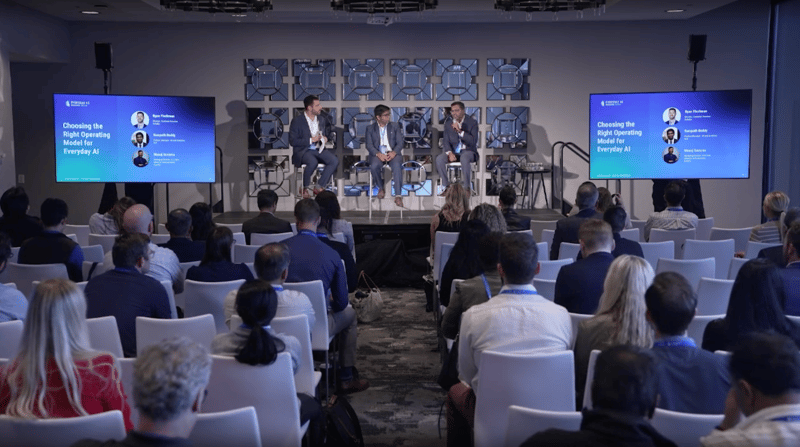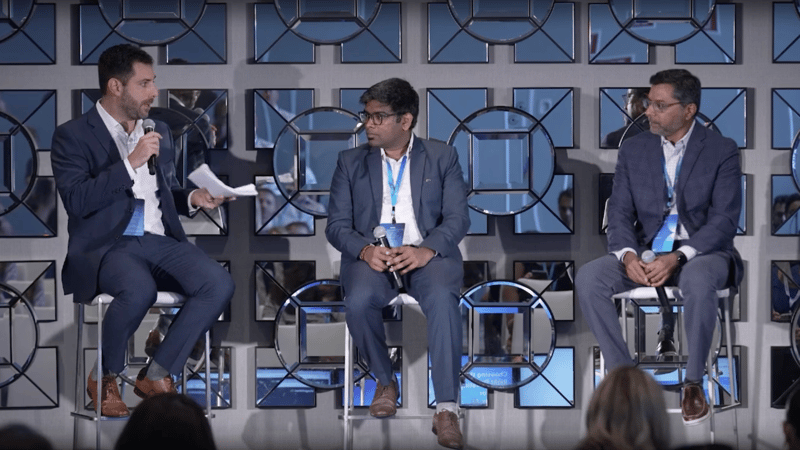Ryan Fischman, Director of Customer Success at Dataiku, led a fireside chat with Sampath Reddy of SLB and Manoj Suvarna of Deloitte in Dallas as part of the Dataiku 2023 Everyday AI Conferences. Reddy, Project Manager of AI and Analytics at SLB, and Suvarna, Managing Director of AI, Data Alliances, and Ecosystems at Deloitte, provided guests with unique and valuable insights on the democratization of AI through case studies and real-world examples.

Taking the Leap Into Generative AI
Reddy began the conversation describing his company’s partnership with Dataiku and the key problem SLB had when starting to implement AI into their organization. SLB, the world’s largest oilfield services company driving innovation for a balanced planet, partnered with Dataiku in 2018. They understood that to successfully implement Generative AI, they had to define and utilize two key assets — their data scientists and their domain experts. “Domain experts had access to data and ideas,” Reddy says, “but they didn’t know what to do with them. On the other hand, we have data scientists, who aren’t given the context of the data they’re working on.”
They quickly learned that the AI technology was just one piece of the puzzle and that it was important to bridge the gap between people and technology in the right way. They didn’t set out to “make domain experts data scientists, or to make data scientists learn how an entire industry works.” They found success in raising the competency levels of both groups of people by providing them with a common platform.
We know that the future will be building things on AI. We just need to be ready with the workforce of the future.
Meanwhile, Suvarna explained that Deloitte serves thousands of clients across six industries and 13 different subsectors, so their analysis has included companies that have a full-scale center of excellence surrounding AI, and others who have a couple of data scientists just starting their AI journey. And through their comprehensive industry benchmarking surveys, they have found that “clients tend to fall into four different categories, with varying degrees of implementation and adoption.”
The interesting trend is that the population in these groups is very evenly spread, where 27% of the total are in the “Transformer” group with high levels of both AI in production and also business outcomes driven, which means the other 73% are still finding their way. This suggests that deployment of AI in organizations is very much a growing, burgeoning process.
Building a Strong Generative AI Foundation
Moderator Ryan Fischman of Dataiku shifted the conversation to real-world scenarios. “Let’s say you have a client that is just getting started in AI and wants to have an AI center of excellence. Where do you recommend they begin? What should they ask themselves?”
Suvarna explains, “Number 1 is having a strategy. It’s not about what cool tool or cool technology is out there. Number 2 is having the right data.”
Having accessible data to build models is critical. Without data, there is no AI.
Suvarna also points out that the required data to execute a successful strategy might live in different organizational silos, and privacy and security issues might also hamper efforts to build a strong operational model. “Third is the environment and skillset. If you don’t have the right culture or talent in the organization, it doesn’t really matter. The fourth aspect is how you are setting up a governance strategy around it. Making sure the overall direction and oversight of any strategy is important, but perhaps more so when it involves disparate teams and disparate datasets. The trustworthiness factor is important because at the end of the day, it’s garbage in, garbage out. That’s going to lead to distrust by the people using it, so you’re back to square one.” To learn more, check out the flipbook, “How to Build Trustworthy AI Systems.”
Getting Organizational Buy-In to Implement AI
Fischman continued, “The biggest thing is change management — getting folks to buy into a new way of thinking. How did you start to gain organizational buy-in? What hurdles did you have to overcome?”
Reddy recommends starting on what he calls, “humble ground.” SLB understood that the inclusion of AI into everyday tasks was going to be a journey — that it was going to take time. He also added that at times human nature is unavoidable. “People will typically be more comfortable with what they’re already doing. If you try to bring in a huge change, that’s going to be a big shock for them. It might work if you put in an organizational mandate, but people will always find a shortcut and never really adopt it.”
The best guidance Reddy has is to play to people’s strengths. “We’re not going to have our data scientists understand the data and content, and also build pipelines. Our domain experts understand the data better than anyone else. That’s when we started making them responsible for the outcomes.”

Building Trust by Increasing Competency
Reddy also sees a long-term net positive effect of increasing competency, one that might actually translate into financial gain. “The problem we face in the energy industry is the value cost of failure. If the model is going to generate an outcome and it ends up being wrong, what kind of cost do we incur?” By building the domain experts into the development loop, and creating these processes has helped with building trust in the organization, he notes that, “our processes are getting fast-tracked because everyone has a role to play.”
This trend of increasing competency resonates with Suvarna. “This isn’t a journey that can be done overnight,” he says. He notes that the average time frame for organizations to truly become members of the Transformer quadrant he mentioned earlier (delivering high outcomes and more applications in production) was between five and seven years. However, with the velocity at which Generative AI is moving, the timelines are likewise accelerating.
Most organizations do tend to start small, designing a couple of AI use cases and models to experiment with, to prove value for the larger organization. This seems to be the turning point for Suvarna. “There will be more questions and more requirements that’ll come in, which will then trigger questions around how to democratize it to the broader organization.” He acknowledges that this is the point where tools like Dataiku come into the picture, where the broader organization is expanding and leveraging more and more use cases.
As more and more industries leverage Generative AI, Suvarna makes an interesting point about working with competition instead of running up against it. “I can give an example of a large media and entertainment company. They realized the fact that they’re one of the largest owners of stock photos, but capabilities like Dall-E are going to crush their business.” To get ahead of this, he suggests embracing the competition. “Create the same kind of images,” he says, “and serve it back to the same clients.”
Negotiating Bottlenecks and Roadblocks
Fischman continues, “When you have organizational buy-in from domain experts and data scientists and are moving forward, what are some of the roadblocks you see?”
Suvarna responds, “Beyond the executive commitment and investment, the big challenge is how you integrate AI into the traditional workflow of the organization.”
The reality is that you’re flying the plane as you’re building it.
Organizations can’t afford to stop what they’re doing to implement AI — they must identify connections where AI can be used to augment or optimize existing processes, “so that it gradually, seamlessly, becomes a component of the overall solution,” he says.
Reddy adds, “Innovation has always been a driving factor for us. It was easy for people to get hold of a platform where they can experiment, play around, and build things. The challenge we faced was the overutilization of resources.” When given “unlimited” cloud resources, team members quickly found that there is a limit to resources no matter where you go. The exercise then became how to find the right-sized solutions for big problems. “We resolved this by creating a system infrastructure so team members do their job effectively,” so that team members across the organization understand the value-adds AI provides.
On the topic of cost of ownership, Suvarna adds that, “with Generative AI, you can do all the coolest stuff, but it’s going to cost you — the GPUs and cloud resources you have. The more questions you ask, the more compute it has to drive.” He pushes the alignment between IT, data scientists, and business leadership. “It’s a three-legged stool,” he says. “They need to come together and get the prioritizations on the table, unlock value, and secure the budget so you can do additional things.”
Accelerating Innovation From Clear Foundational Models
“How much easier has the innovation been because of the foundational operating model you had?” Fischman asks.
Reddy mentions a new role at SLB born from these foundational models. “We call them domain data scientists. They are domain experts who have been cross trained to have the skills of data scientists, so they become a bridge between the business side and data scientists.” He notes that fundamental changes like these haven’t changed the way they operate, but they have accelerated the speed at which they can execute. “It’s faster now, both in bringing in new tools, reusing them where it makes sense, and also contextualizing them into domains — that’s where the value has been.”
Wrapping up the conversation, Fischman asks Suvarna, “What are you most looking forward to seeing in the survey this year?”
“The timeline of how quickly AI is being implemented in business,” he responds. “In the last six to nine months, we’re seeing some clients that were only playing around with Generative AI putting things in production.”
The industry surrounding Generative AI and machine learning is accelerating rapidly, and only seems to be moving faster. SLB and Deloitte have been valued partners of Dataiku for years, and for organizations, businesses, and industries looking to enter a transformative time in their AI or ML development, the knowledge of real-world application of Generative AI strategies into large organizations couldn’t come at a better time.




